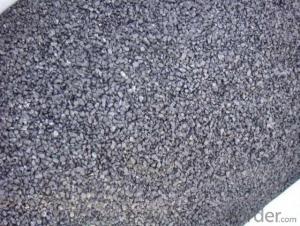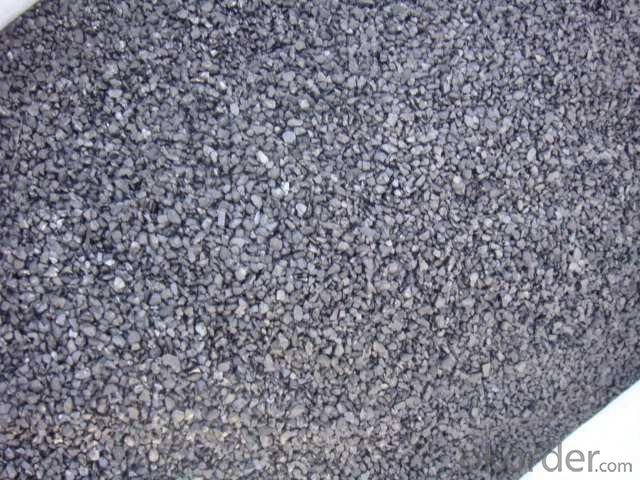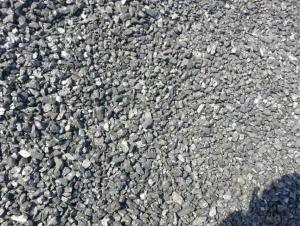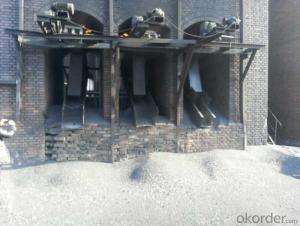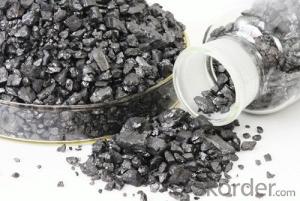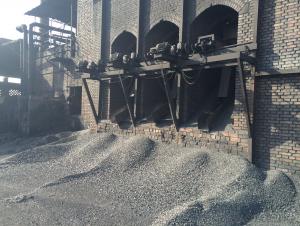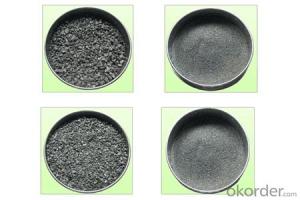FC93 Calcined Anthracite CNBM Low Price
- Loading Port:
- Tianjin
- Payment Terms:
- TT OR LC
- Min Order Qty:
- 0 m.t.
- Supply Capability:
- 100000 m.t./month
OKorder Service Pledge
OKorder Financial Service
You Might Also Like
Packaging & Delivery
Packaging Detail: | 25kgs/50kgs/1ton per bag or as buyer's request |
Delivery Detail: | Within 20 days after receiving corect L/C |
Feature
All of our goods are made in the best quality of world famous Tianjin. All of our products are with High carbon, Low ash, low sulphur, Low Moisture.
Usage
The Calcined Anthracite Coal/Gas Calcined Anthracite Coal/Carbon Raiser is mainly used in steelmaking in electrical stove, screening water, shipbuilding sandblast to remove rust. It can reduce the cost of steelmaking effectively by replacing the traditional petroleum coke of carburant.Also can improve the Carbon content in steel-melting and Ductile iron foundry.
Specifications
Calcined Anthracite
Fixed carbon: 90%-95%
S: 0.5% max
Size: 0-3. 3-5.3-15 or as request
PARAMETER UNIT GUARANTEE VALUE | |||||
F.C.% | 95MIN | 94MIN | 93MIN | 92MIN | 90MIN |
ASH % | 4MAX | 5MAX | 6MAX | 7MAX | 8MAX |
V.M.% | 1 MAX | 1MAX | 1.5MAX | 1.5MAX | 1.5MAX |
SULFUR % | 0.5MAX | 0.5MAX | 0.5MAX | 0.5MAX | 0.5MAX |
MOISTURE % | 0.5MAX | 0.5MAX | 0.5MAX | 0.5MAX | 0.5MAX |
Size can be adjusted based on buyer's request.
Picture

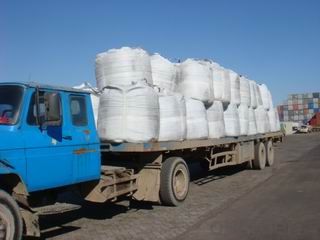
- Q: When will amines be fertilized?
- Carbon is the most commonly used varieties of amine fertilizer, with nitrogen and phosphorus fertilizer, fertilizer use, fertilizer is generally 120 days or so, the suitable conditions of temperature, moisture in the next 50 days after applying fertilizer best.Carbon amine is a white compound that is granular, plate-like or columnar crystalline. Because ammonium bicarbonate is a carbonate, it must not be placed with acids because the acid reacts with ammonium bicarbonate to form carbon dioxide, which causes ammonium carbonate to go bad. However, in the rural areas, ammonium carbonate and acid reaction are also used. The ammonium bicarbonate is placed in the vegetable greenhouse, and the greenhouse is sealed, and ammonium bicarbonate is placed at the top, adding hydrochloric acid. At this point, the amines react with hydrochloric acid to produce ammonium chloride, water, and carbon dioxide. Carbon dioxide can promote plant photosynthesis, increase vegetable production, and the resulting ammonium chloride can also be used as fertilizer again. Ammonium bicarbonate in the chemical formula of ammonium ion, is an ammonium salt, and ammonium salt and alkali can not be put together, so ammonium bicarbonate and sodium hydroxide or calcium hydroxide should not be put together
- Q: What are the impacts of carbon emissions on urban environments?
- Urban environments are significantly affected by carbon emissions, with air pollution being one of the most notable consequences. The release of carbon dioxide and other greenhouse gases from vehicles, factories, and power plants contributes to the formation of smog and harmful particulate matter in cities. This pollution poses serious health risks to residents, especially those with respiratory conditions, and can result in increased hospital admissions and premature deaths. In addition, carbon emissions contribute to climate change, which has wide-ranging implications for urban areas. Rising temperatures and changing weather patterns can intensify heatwaves, leading to an increase in heat-related illnesses and fatalities. The frequency and severity of extreme weather events, such as hurricanes and floods, can cause significant damage to infrastructure and disrupt essential services like water supply and transportation. Furthermore, coastal cities face the threat of rising sea levels as a result of carbon emissions. The melting of polar ice caps and the expansion of seawater contribute to flooding and erosion, particularly in these areas. This can lead to the loss of valuable land, displacement of populations, and damage to critical infrastructure such as buildings, roads, and sewage systems. Additionally, carbon emissions contribute to the urban heat island effect, whereby cities experience higher temperatures compared to surrounding rural areas. This is due to the absorption and retention of heat by urban materials like concrete and asphalt. The urban heat island effect can worsen the health risks associated with heatwaves and increase the demand for cooling, thus furthering carbon emissions. Lastly, carbon emissions have economic ramifications for urban environments. The costs of mitigating and adapting to climate change effects, such as implementing climate-resilient infrastructure and disaster response measures, can be substantial. Additionally, air pollution and extreme weather events can result in increased healthcare expenses and productivity losses. To address these impacts, it is crucial to reduce carbon emissions by transitioning to cleaner energy sources, promoting sustainable transportation options, and implementing energy-efficient practices in buildings. Urban planning and design should also prioritize the creation of green spaces, tree planting, and the use of reflective and permeable materials to combat the urban heat island effect. By tackling carbon emissions in urban environments, we can create healthier and more resilient cities for present and future generations.
- Q: How is carbon used in the production of ink?
- Various forms of carbon, such as carbon black or activated carbon, are employed in the production of ink. Carbon black, a fine black powder derived from incomplete petroleum combustion, is commonly used as a pigment to achieve deep black color in inks. Its small size and high surface area enable even dispersion in the ink, ensuring consistent color. On the other hand, activated carbon is a porous carbon form produced by heating materials like wood or coconut shells at high temperatures. In ink production, it functions as a filter or purification agent. With its extensive surface area and microscopic pores, activated carbon effectively adsorbs contaminants and impurities from the ink, enhancing its quality and stability for a smooth flow. In addition to its purification role, carbon also serves as a conductive material in ink production. Carbon-based inks, widely utilized in applications requiring electrical conductivity such as printed circuit boards, sensors, or electronic devices, consist of dispersed carbon particles in a liquid medium. This allows them to be printed or deposited onto a substrate, creating conductive pathways. Overall, carbon's vital role in ink production encompasses providing color, acting as a purification agent, and enabling electrical conductivity. Its adaptable properties and vast range of applications establish it as an indispensable component in the ink manufacturing process.
- Q: How does carbon impact biodiversity?
- Carbon impacts biodiversity in several ways. Firstly, carbon dioxide is a greenhouse gas that contributes to climate change, leading to shifts in temperature and precipitation patterns. These changes can disrupt ecosystems and alter habitats, affecting the distribution and survival of various species. Additionally, excess carbon in the atmosphere can lead to ocean acidification, which negatively affects marine biodiversity by harming coral reefs and other organisms reliant on calcium carbonate structures. Finally, deforestation and land-use changes associated with carbon emissions result in habitat loss, further reducing biodiversity. Overall, carbon emissions have significant and detrimental impacts on the delicate balance of ecosystems and the diversity of life on Earth.
- Q: How does carbon impact air quality?
- Carbon can have a significant impact on air quality through the release of carbon dioxide (CO2) and other carbon-based pollutants into the atmosphere. The burning of fossil fuels, such as coal, oil, and natural gas, releases large amounts of carbon dioxide, which is a greenhouse gas responsible for climate change. Increased levels of carbon dioxide in the atmosphere contribute to the warming of the Earth's surface, leading to adverse effects on air quality. Furthermore, carbon-based pollutants, including carbon monoxide (CO) and volatile organic compounds (VOCs), can be emitted during the incomplete combustion of fossil fuels or other organic materials. These pollutants have harmful effects on human health and can contribute to the formation of ground-level ozone, a major component of smog. Ozone can cause respiratory problems, lung damage, and worsen existing respiratory conditions such as asthma. Additionally, carbon particles, known as black carbon or soot, are released from the burning of fossil fuels, biomass, and other organic matter. These particles can directly impact air quality by absorbing sunlight and reducing visibility. Moreover, when these particles are inhaled, they can penetrate deep into the lungs, causing respiratory issues and potentially leading to long-term health problems. Reducing carbon emissions is crucial for improving air quality and mitigating the negative impacts on human health and the environment. Transitioning to cleaner and more sustainable energy sources, such as renewable energy, can help reduce carbon emissions and improve air quality. Implementing stricter regulations and emission standards for industries and vehicles can also contribute to reducing carbon pollution and improving overall air quality.
- Q: What is the symbol for carbon?
- The symbol for carbon is "C".
- Q: Does iron have more carbon or more steel?
- carbon content of less than 0.04% of the iron, the carbon content in the name of wrought iron; 0.05~2% iron, known as steel.
- Q: What are the effects of carbon emissions on the stability of urban infrastructure?
- Carbon emissions have a significant impact on the stability of urban infrastructure. The release of carbon dioxide and other greenhouse gases into the atmosphere from various sources, such as industrial activities, transportation, and energy production, contribute to climate change. This, in turn, poses several challenges to urban infrastructure. One of the primary effects of carbon emissions on urban infrastructure stability is the increased frequency and severity of extreme weather events. Climate change leads to more intense heatwaves, storms, hurricanes, and flooding, which can cause significant damage to buildings, roads, bridges, and other infrastructure components. Higher temperatures can also lead to the expansion and contraction of materials, resulting in structural issues and decreased durability. Moreover, carbon emissions contribute to rising sea levels due to the melting of polar ice caps. This puts coastal cities at risk of flooding and erosion, threatening critical infrastructure located in these regions. As sea levels continue to rise, the stability of urban infrastructure, including ports, water treatment facilities, and transportation systems, is compromised. Another consequence of carbon emissions on urban infrastructure stability is the impact on energy supply and demand. As climate change progresses, extreme weather events can disrupt power grids and energy infrastructure, leading to blackouts and disruptions in services. Additionally, increased energy demand for cooling systems in response to rising temperatures can overload existing infrastructure, putting strain on the electrical grid. Furthermore, carbon emissions contribute to air pollution, which adversely affects the health and well-being of urban populations. Poor air quality can lead to respiratory and cardiovascular diseases, impacting the workforce and productivity. This can indirectly affect the stability of urban infrastructure as a healthy and productive population is essential for the maintenance and functioning of cities. To mitigate the effects of carbon emissions on the stability of urban infrastructure, various measures can be taken. These include shifting to renewable energy sources, improving energy efficiency in buildings and transportation, implementing sustainable urban planning strategies, and investing in climate-resilient infrastructure. These actions can help reduce carbon emissions and build infrastructure that is better equipped to withstand the challenges posed by climate change, ultimately ensuring the stability and resilience of urban areas.
- Q: Can carbon in barbecue cause cancer? Can carbonated food cause cancer?
- It will be。WHO published 3 years of research results, said barbecue foods produce carcinogenic substances are toxic, "eat barbecue, equivalent to smoking."". A US research center report even said eating a roast chicken leg is equivalent to the toxicity of 60 cigarettes; women who eat barbecue are 2 times more likely to develop breast cancer than other women.
- Q: What is the importance of carbon dating in archaeology?
- Archaeology heavily relies on carbon dating, which plays a pivotal role in determining the age of artifacts and archaeological sites. This scientific technique is essential for establishing a chronological framework and comprehending the timeline of human history. Carbon dating operates on the principle that all living organisms contain a specific amount of radioactive carbon-14, which undergoes predictable decay over time. By quantifying the remaining carbon-14 in an artifact or organic material, archaeologists can calculate its age. This method is particularly advantageous when dating organic remains like bones, charcoal, and plant fibers, which are frequently unearthed at archaeological sites. The significance of carbon dating lies in its ability to deliver precise and trustworthy estimations of an artifact's age. This information is critical for interpreting and comprehending the context and importance of archaeological discoveries. By assigning an accurate date to an object or site, archaeologists can establish connections between different artifacts, societies, and cultures. This, in turn, aids in reconstructing ancient civilizations and their evolution throughout time. Moreover, carbon dating also contributes to refining and validating historical timelines. It enables archaeologists to cross-reference and authenticate the dating of artifacts and sites by employing alternative dating methods, such as dendrochronology (tree-ring dating) or stratigraphy (the study of rock layers). Employing multiple dating techniques enhances the accuracy and reliability of archaeological interpretations. Carbon dating also assists in identifying and distinguishing genuine artifacts from forgeries. By analyzing the age of an object, archaeologists can determine if it aligns with the claimed historical context. This is especially pertinent in the realm of art and antiquities, where the market for counterfeits can be lucrative. In conclusion, carbon dating is an indispensable tool in archaeology, enabling researchers to establish the chronology of ancient civilizations, validate historical timelines, and identify authentic artifacts. It provides invaluable insights into our past, facilitating a deeper understanding and appreciation of the diverse tapestry of human history.
Send your message to us
FC93 Calcined Anthracite CNBM Low Price
- Loading Port:
- Tianjin
- Payment Terms:
- TT OR LC
- Min Order Qty:
- 0 m.t.
- Supply Capability:
- 100000 m.t./month
OKorder Service Pledge
OKorder Financial Service
Similar products
Hot products
Hot Searches
